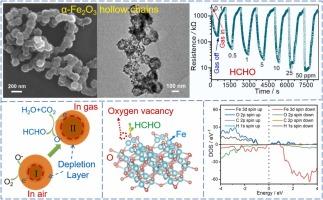高效微波合成碳衍生空心α-Fe2O3纳米链,用于甲醛检测
IF 3.7
1区 化学
Q1 CHEMISTRY, ANALYTICAL
引用次数: 0
摘要
甲醛(HCHO)被广泛应用于制造过程,作为室内空气污染物,它的释放和积累是有贡献的。及时发现HCHO对于防止其严重毒性作用至关重要。为了提高对HCHO的气敏性能,以碳纳米链为模板,采用微波辅助法制备了多孔α-Fe2O3空心纳米链。利用各种表征技术和计算分析来研究其传感性能并探讨其潜在机制。结果表明,α-Fe2O3纳米颗粒在8 ~ 23 nm范围内构建出比表面积为65.69 m2 g-1的α-Fe2O3空心纳米链。这种结构的形成主要归因于微波辐射引起的热点效应。α-Fe2O3传感器在150°C下检测0.1-50 ppm HCHO蒸汽时表现出优异的灵敏度、选择性、快速的响应/恢复和长期的稳定性。值得注意的是,它在150°C下对10 ppm HCHO的响应率为122,响应时间为78秒。多孔空心纳米链具有丰富的氧空位缺陷,其独特的结构可以增强hho传感性能。这项研究提出了一种有前途的、低成本的、高效的方法来开发一种有效的α-Fe2O3传感器来检测低ppm的HCHO。本文章由计算机程序翻译,如有差异,请以英文原文为准。

Carbon derived hollow α-Fe2O3 nanochains via high-efficiency microwave-assisted synthesis for excellent formaldehyde detection
Formaldehyde (HCHO) is widely used in manufacturing processes, contributing to its release and buildup as an indoor air pollutant. Timely detection of HCHO is crucial to prevent its severe toxic effects. To enhance the gas-sensing capability toward HCHO, porous α-Fe2O3 hollow nanochains were successfully synthesized using a microwave-assisted method with carbon nanochains as a template. Various characterization techniques and calculation analysis were used to investigate its sensing performance and explore its underlying mechanism. The results revealed that the α-Fe2O3 hollow nanochains, with a large specific surface area of 65.69 m2 g−1, are constructed from sub-level α-Fe2O3 nanoparticles in the size range of 8–23 nm. The formation of this structure is primarily attributed to the hotspot effect induced by microwave radiation. The α-Fe2O3 sensor demonstrated superior sensitivity, excellent selectivity, swift response/recovery, and long-term stability in detecting 0.1–50 ppm HCHO vapor at 150 °C. Notably, it exhibited a high response of 122 with a response time of 78 s towards 10 ppm HCHO at 150 °C. The enhanced HCHO-sensing properties can be attributed to the unique structure of porous hollow nanochains with abundant oxygen vacancy defects. This research presents a promising, low-cost, and efficient approach for developing an effective α-Fe2O3 sensor for low-ppm HCHO detection.
求助全文
通过发布文献求助,成功后即可免费获取论文全文。
去求助
来源期刊

Sensors and Actuators B: Chemical
工程技术-电化学
CiteScore
14.60
自引率
11.90%
发文量
1776
审稿时长
3.2 months
期刊介绍:
Sensors & Actuators, B: Chemical is an international journal focused on the research and development of chemical transducers. It covers chemical sensors and biosensors, chemical actuators, and analytical microsystems. The journal is interdisciplinary, aiming to publish original works showcasing substantial advancements beyond the current state of the art in these fields, with practical applicability to solving meaningful analytical problems. Review articles are accepted by invitation from an Editor of the journal.
 求助内容:
求助内容: 应助结果提醒方式:
应助结果提醒方式:


